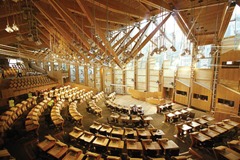What price Scottish independence?
 Esmond Birnie assesses the significant economic and social consequences of either a ‘Yes’ or ‘No’ vote for Northern Ireland.
Esmond Birnie assesses the significant economic and social consequences of either a ‘Yes’ or ‘No’ vote for Northern Ireland.
It’s September 2016 and the soccer season is in full swing. As the Belfast ferry ties up in Cairnryan, Scottish customs officers come aboard demanding the passports of Rangers and Celtic fans and other passengers before letting them disembark. At the same time, lorry drivers queue to have their loads and paperwork inspected before being allowed to head south – and to repeat the process again at the English border.
Fiction? Not a bit of it; this is just one possible reality facing Northern Ireland as it come to terms with the possibility of an independent Scotland.
On 18 September 2014, the people of Scotland will go to the polls and face the question: “Should Scotland be an independent country?” If a majority of Scottish residents aged over 16 vote ‘Yes’, Scotland will become an independent nation on 24 March 2016.
But apart from ending 300 years of UK membership, just what would independence mean for Scotland, the rest of the UK and particularly for Northern Ireland?
Back in June 2013, the Scottish Chambers of Commerce surveyed 800 members of the Scottish business community, asking who would be affected by independence and how? The answers summarised the state of the independence debate: 71 per cent said their business would be affected by independence but 60 per cent said they didn’t have enough information to determine the actual impact of independence.
On the face of it, the absence of informed debate around independence is surprising, particularly as more than 65 per cent of total Scottish ‘external sales’ are destined for the rest of the UK, while 90 per cent of customers of Scottish financial services institutions live in the rest of the UK. In 2012, £21 billion of Scottish non-oil exports were destined for the world beyond the UK and in the same year Scottish imports from the rest of the UK alone were worth around £59 billion.
With that sort of mutual reliance, you would have thought clarity around the implications of independence would be vital – but there are a couple of reasons why that’s not so.
The first is that there has been a general assumption that independence was a no-hoper. Take out the ‘don’t-knows’ and ‘won’t-tells’ and the ‘No’ camp was sitting on a comfortable 60:40 percentage point lead – that is, until recently. Second and more fundamental is that most of the key decisions that will define the shape and structure of an independent Scotland won’t be negotiated till after the referendum.
Consequently, until now the debate frequently became a slanging match between the pro-independence Scottish Government and the Better Together pro-union campaign, while the policy papers from think tanks, lobby groups and industry bodies have gone largely ignored by the majority of Scots.
Adding to the complexity is the reality – largely missed by the majority in the rest of the UK –that even a ‘No’ vote will have consequences. If the Scottish people reject independence, the Scotland Act 2012 will continue to change the tax and reward systems north of the border, while the potential for accelerated fiscal devolution will further impact on clients across the UK and beyond.
But now that the Yes:No gap has narrowed sharply and the serious debating has begun, just what are the facts surrounding an independent Scotland?
The Scottish Government published its blueprint for independence on 26 November 2013 in a 649-page White Paper: ‘Scotland’s Future: Your guide to an independent Scotland’. Underlying many of the commitments made in the White Paper are two vital assumptions: that Westminster will agree to a eurozone style currency union that retains sterling; and that the EU member states will agree to an independent Scotland moving seamlessly out of the UK, into the EU and retaining all the UK’s opt-outs and rebates, including membership of the vital Common Travel Area.
Underlying these is a further assumption that Scotland will successfully negotiate the key fiscal and EU relationships in good time for everything to be in place by ‘Independence Day’ on 24 March 2016.
The final assumption is that an SNP Government will be elected in the first independent Scottish elections, also scheduled for 2016.
Clarity on the two key assumptions has been obscured by a declaration from the Chancellor – supported by the Liberal Democrats and Labour – that a currency union will not be on offer; and the decision by European Parliament President Martin Schulz to stop publication of legal advice on whether an independent Scotland could be fast-tracked to EU membership because it could amount to “interference” in the independence debate.
Amongst the raft of commitments in the White Paper is a pledge to cut corporation tax by up to 3 percentage points below the Westminster rate and a commitment to reduce air passenger duty by 50 per cent – neither of which will be welcomed by the Northern Ireland business community.
Assuming the referendum says ‘Yes’ to independence, there are three plausible scenarios:
• a currency union and a “seamless move” from the UK into the EU as envisaged in the Government’s White Paper;
• a “messy divorce” where the rest of the UK (or rUK as it’s increasingly being described) refuses sterling currency union and where EU membership is refused, or (more plausibly) subject to a prolonged formal application for membership as a new member state; or
• a “limbo land” where the key agreements just can’t be pushed over the line by Independence Day, with Scotland facing a period of time outside both rUK and the EU.
All potentially have implications for Northern Ireland and Northern Ireland businesses, some more profound than others. One of the most significant is the Common Travel Area (CTA). Recognised under the Amsterdam Treaty (which saw other member states adopt the Schengen Area with common rules on visas, and police and judicial cooperation), the CTA provides for free travel between the UK, Channel Islands, Isle of Man and the Republic of Ireland for citizens or those who have cleared immigration at the point at which they entered the CTA.
An independent Scotland, outside the EU and which does not negotiate its way into the CTA may have to implement – or face their neighbours implementing – ‘hard’ borders that may require examination of identity documents and control, or limit, the free movement of goods, services, people (including workers) and capital.
And what if the absence of a sterling currency union drives an independent Scotland towards the euro (or even the Scottish merk, groat or dollar) which is also an option in the White Paper?
Another issue for Northern Ireland would be Westminster’s view on Scottish independence as an opportunity to reform the Barnett formula. An independent Scotland would no longer enjoy Barnett funding of around £10,100 per person and the Government may see this as an opportune moment to reform the 1978 arrangement for the rest of rUK.
But it might go further.
In its May 2010 Programme for Government, the Coalition Government said that “… any change to the system [of devolution finding] must wait the stabilisation of the public finances” … accepted as no change to Barnett in the current parliament. This was borne out in Westminster Scottish Questions on
18 December 2013, when Scottish Secretary Alistair Carmichael reiterated that there would be no review of Barnett “in this Parliament” – widely taken by Scottish MPs and others to mean, in the event of a ‘No’ vote a review of Barnett, is on the cards.
Finally, even a ‘No’ vote changes the Scottish status-quo. The Scotland Act will deliver significant devolution that may well be supplemented with more fiscal devolution in advance of the referendum. Wales will get some form of a Wales Bill to reflect the outcomes of the Silk Commission, while the Heseltine review of the English regions, alongside developments in the London Mayor’s office, will deliver devolution there too.
Whether the referendum delivers ‘Yes’ or ‘No’, that leaves Northern Ireland as the only part of the UK not to have experienced a comprehensive review of fiscal devolution.
Esmond Birnie is chief economist with PwC in Northern Ireland.
Esmond can be contacted on 028 9024 5454 or esmond.birnie@uk.pwc.com







